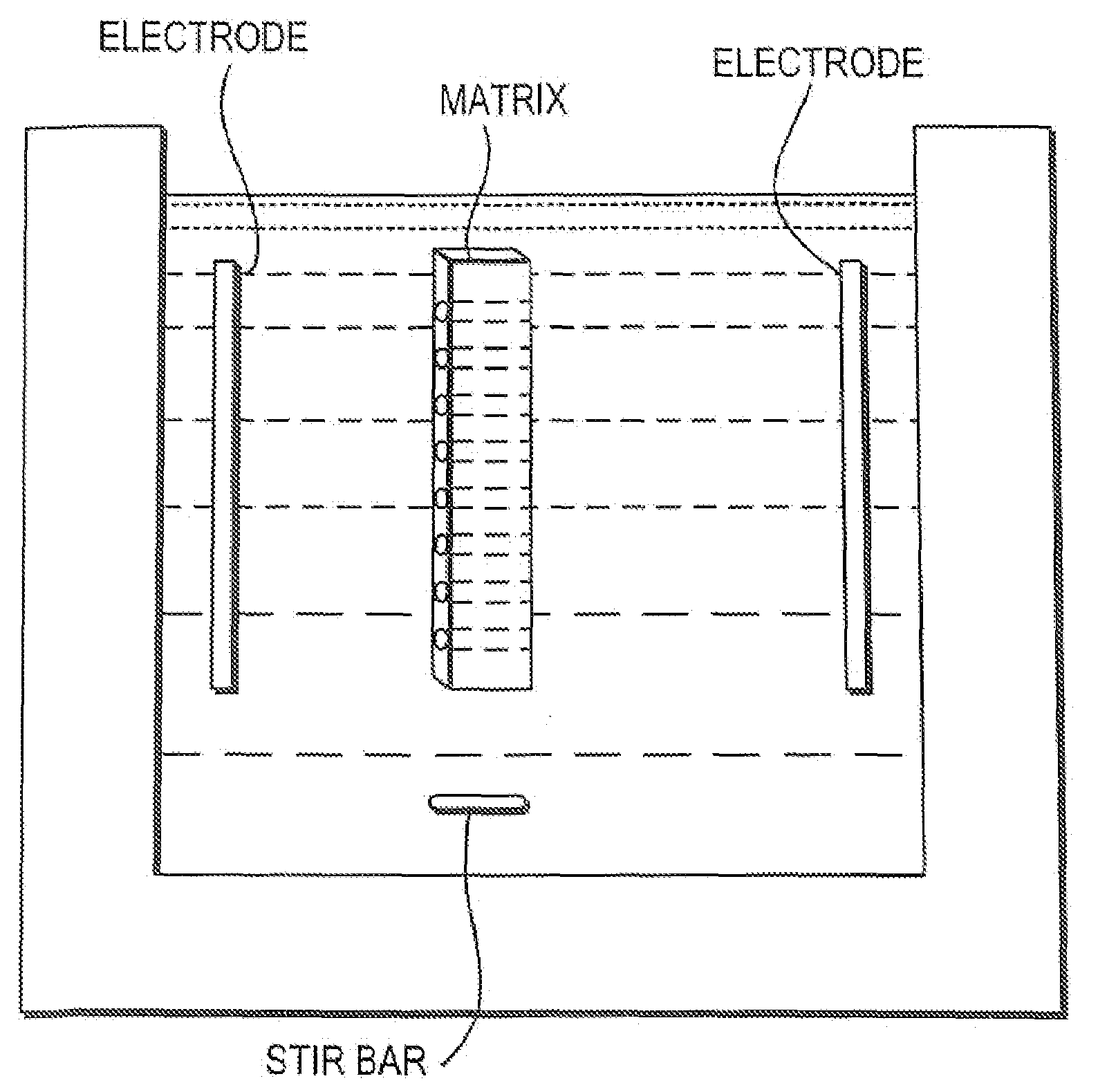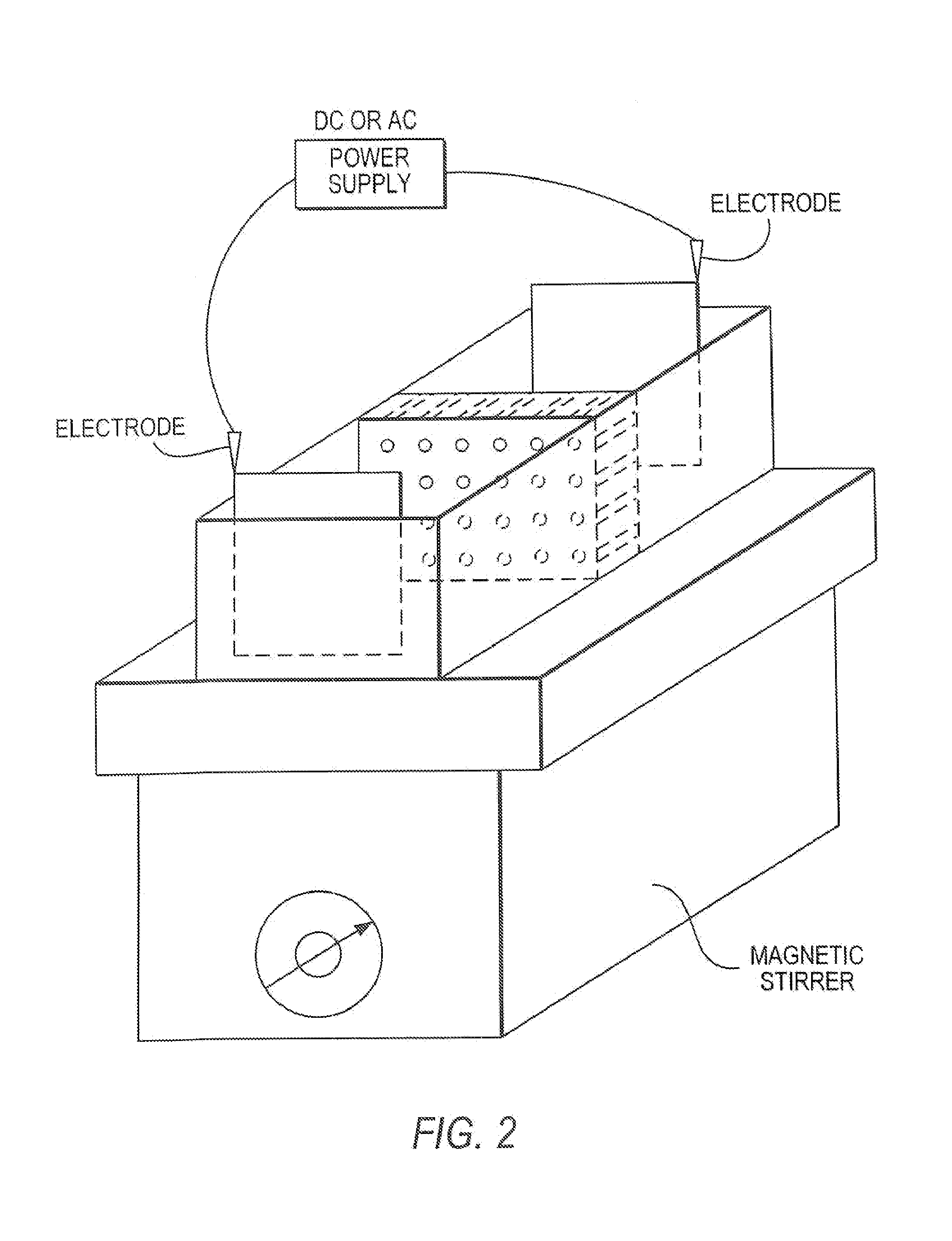Matrixes, arrays, systems and methods
a technology of arrays and matrixes, applied in the field of matrixes and arrays, can solve the problems of difficult to manufacture gels with incrementally small ph changes within a ph gradient to improve the linear dispersion of proteins, and require a relatively long time to separate proteins, etc., to achieve the effect of enhancing the detection of biomolecules
- Summary
- Abstract
- Description
- Claims
- Application Information
AI Technical Summary
Benefits of technology
Problems solved by technology
Method used
Image
Examples
example 1
Molecular Weight Standards
[0125]A groove of dimensions 0.1×0.1×3.0 mm was engraved in a thin para-methoxymethylamphetamine (PMMA) plate. The groove as filled with 10% SDS polyacrylamide gel. At one end of the lane, a spot of IEF buffer having an immobilized pH of 8.80 (arbitrarily chosen) was deposited. On hundred ngs of a protein ladder marker RPN 800 by Amersham Pharmacia Biotech (10 to 250 kD in molecular weight) were injected into the spot. A metallic electrode was connected to the immobilized pH gradient gel and another metallic electrode was connected to the end of the lane furthest away from the pH.
[0126]The plate was immersed in a 1%SDS 50 mM tris-glycine buffer (pH 8.3). A voltage of 36 Volts (field˜100 v / cm) was applied to the electrodes for 5 minutes. Next, the lane was silver stained and fixed.
example 2
Two Dimensional Analysis of the Proteins of Blood Plasma at pH 8.65±0.05
[0127]A 100 micron diameter spot of a pH gel with pH value of 8.65±0.05 (polyacrylamide gel mixed with a buffer solution) was deposited on a polymer wafer, such as PMMA that is 1 cm×1 cm×0.3 mm. The wafer was placed in a small chamber comprising a stir bar and filled with 1M sodium sulphate buffer as a running buffer. 100 ng of blood plasma sample was introduced into the chamber (1 cm×1 cm×0.2 cm) comprising 200 ul of running buffer. A voltage of 50V was applied perpendicular to the plane of the wafer for 5 minutes width 180 degree changes in the direction of the current every 0.5 minutes. Next, the wafer was removed from the running buffer and rinsed in distilled water. The gel spot was removed from the wafer and placed at one end of a lane (10% SDS-PAGE) on a plate as described in Example 1.
[0128]The plate was immersed in a 1%SDS 50 mM tris-glycine buffer (pH 8.3). A voltage of 36 Volts (field˜100 v / cm) was ap...
example 3
Two Dimensional Analysis of Blood Plasma at pH 7.50 to 8.50
(1) The IEF Buffers
[0129]Fifty IEF buffers having pH values of 7.50 up to 8.50 in steps of 0.02 pH units were prepared.
[0130]a. IEF Buffers pH 7.50–7.68, 10% Polyacrylamide
[0131]25 mls 0.1M N-2-hydrosyethylpiperisine-N-3-propansulfonic acid (EPPS) (25,232 g / L) was mixed with 5 grams polyacrylamide (Biorad) and a volume of 0.1M NaOH as indicated below. The volume of the mixture was increased up to 50 mls with water at 25 degrees C.
[0132]
pH = 7.500.1 M NaOH 5.9 mlpH = 7.520.1 M NaOH 6.1 mlpH = 7.540.1 M NaOH 6.3 mlpH = 7.560.1 M NaOH 6.7 mlpH = 7.580.1 M NaOH 6.9 mlpH = 7.600.1 M NaOH 7.0 mlpH = 7.620.1 M NaOH 7.2 mlpH = 7.640.1 M NaOH 7.3 mlpH = 7.660.1 M NaOH 7.4 mlpH = 7.680.1 M NaOH 7.5 ml
[0133]b. IEF Buffers Having pH 7.70–7.88, 7% Polyacrylamide
[0134]25 mls 0.1M N,N-bis(2-hydroxymethyl) glycine (BICINE) (16,317 g / L) was mixed with 3.5 grams polyacrylamide gel (Biorad) and a volume of 0.1M NaOH as indicated below. The vol...
PUM
| Property | Measurement | Unit |
|---|---|---|
| Volume | aaaaa | aaaaa |
| Volume | aaaaa | aaaaa |
| Volume | aaaaa | aaaaa |
Abstract
Description
Claims
Application Information
 Login to View More
Login to View More - R&D
- Intellectual Property
- Life Sciences
- Materials
- Tech Scout
- Unparalleled Data Quality
- Higher Quality Content
- 60% Fewer Hallucinations
Browse by: Latest US Patents, China's latest patents, Technical Efficacy Thesaurus, Application Domain, Technology Topic, Popular Technical Reports.
© 2025 PatSnap. All rights reserved.Legal|Privacy policy|Modern Slavery Act Transparency Statement|Sitemap|About US| Contact US: help@patsnap.com



